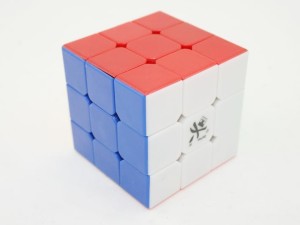I was much younger than I am today when I first heard of the Rubik’s cube. My friend Stan and I scraped together some money, bought ourselves knockoff cubes and a decoder book, and practiced until we could finally solve it. While we impressed no one, we had a lot of fun, until, of course, we moved on to other things and eventually forget the Secret Of The Cube.
Recently however I needed a Rubik’s Cube for a software game idea, and took a first look (as I often do) on eBay. Lo and behold, the modest Rubik’s Cube of our youth has transformed into a majestic beauty: The Speed Cube.  For those not aware, the Speed Cube (and the ‘sport’ of Speed Cubing) is where people solve the puzzle in incredible times: The current record, held by Mats Valk of the Netherlands, is a solved cube in 5.55 seconds!
For those not aware, the Speed Cube (and the ‘sport’ of Speed Cubing) is where people solve the puzzle in incredible times: The current record, held by Mats Valk of the Netherlands, is a solved cube in 5.55 seconds!
Of course, if you’ve played with a Rubik’s Cube, then you know they aren’t built for speed. They twist with difficulty, and if you want to go from one direction to another (called cornering), then you have to line the blocks of each layer up very carefully, or else it all jams.
So you can imagine that a speed cube is different, and they are:
- The blocks of every layer are notched at the corners, so you don’t have to be as careful cornering, which is a huge difference in speed.
- The cube has a bit of ‘stretch’ to it (that is, more loosely held together than a regular one), so there’s some give as you move layers, which means easier turning of slices (rows of blocks in a layer), and easier cornering.
- They are smooth. With some of them, you can spin layers with a flick of a finger!
Anyways, after a few minutes of learning about Speed Cubing, I knew I couldn’t settle for the traditional Rubik’s Cube – even if I never went to an event and competed, I needed the professional’s cube.
Good news – after a bit of searching I found a Dayan GuHong for under $10 (Dayan is a favorite company for Speed Cubers).
Even better – I got a solid color cube. For those who know cubes, you also know the little stickers on each side quickly wear out. With solid coloring, there’s nothing to replace, and everything stays visible.
Two weeks later, it arrived. First impression was how slick it was. I turned a slice with my Rubik’s-attuned hands and overshot – a lot. While mine doesn’t spin rows with a flick of the finger, it still moves very easily. And cornering was incredible. I can actually change direction about 1/3 of a block in, and the cube shifts for me – it’s that flexible. The time saved in not matching the block edges up exactly were huge. In fact, with just a few day’s practice (and I admit, working off a cheat sheet) I’ve been getting down to a mildly respectable 4 minutes (which is about the time it would take for Mats to solve 40 cubes!)
Now I possibly could go out and get a cheap video game for $10 that would keep me entertained, but I am having a lot more fun with this cube – and no batteries necessary! If you are a fan of Rubik’s cubes, then as they say, you owe it to yourself to try a real Speed Cube. Look for Dayan (the maker), and GuHong, ZhanChi
or PanShi
models.
If you remember Rubik’s Cubes from your youth, or just want to try one, I recommend a Speed Cube. It’s a great way to enjoy a puzzle favorite, and definitely the easiest way to solve a Rubik’s Cube I’ve ever encountered!
